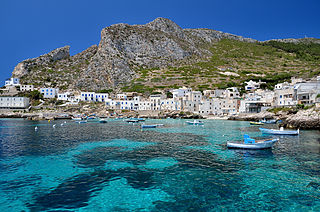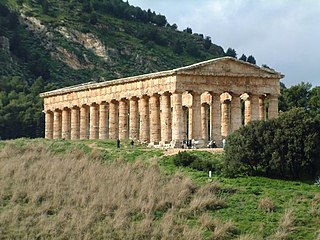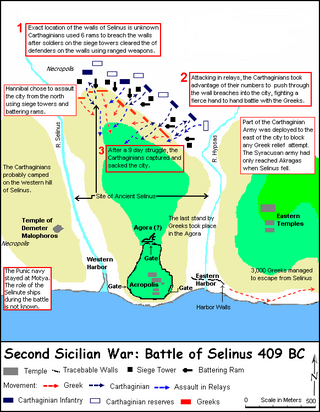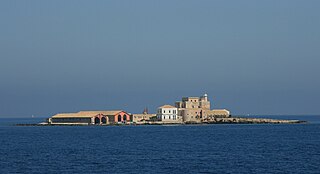
The Aegadian Islands are a group of five small mountainous islands in the Mediterranean Sea off the northwest coast of Sicily, Italy, near the cities of Trapani and Marsala, with a total area of 37.45 square kilometres (14.46 sq mi).

Sicily is the largest and most populous island in the Mediterranean Sea and one of the 20 regions of Italy. It is one of the five Italian autonomous regions and is officially referred to as Regione Siciliana. The island has 4.8 million inhabitants. Its capital city is Palermo. It is named after the Sicels, who inhabited the eastern part of the island during the Iron Age.

Trapani is a city and municipality (comune) on the west coast of Sicily, in Italy. It is the capital of the Province of Trapani. Founded by Elymians, the city is still an important fishing port and the main gateway to the nearby Egadi Islands.

Erice is a historic town and comune in the province of Trapani, Sicily, in southern Italy. It is a member of the I Borghi più belli d'Italia association.

Marsala is an Italian town located in the Province of Trapani in the westernmost part of Sicily. Marsala is the most populated town in its province and the fifth in Sicily.

Mazara del Vallo is a town and comune in the province of Trapani, southwestern Sicily, Italy. It lies mainly on the left bank at the mouth of the Mazaro river.

The province of Trapani is a province in the autonomous island region of Sicily, Italy. Following the suppression of the Sicilian provinces, it was replaced in 2015 by the free municipal consortium of Trapani. Its capital is the city of Trapani. It has an area of 2,469.62 square kilometres (953.53 sq mi) and a total population of 433,826 (2017). There are 25 comuni in the province.

Sant'Antioco is the name of both an island and a municipality (comune) in southwestern Sardinia, in the Province of South Sardinia, in Sulcis zone. With a population of 11,730, the municipality of Sant'Antioco it is the island's largest community. It is also the site of ancient Sulci, considered the second city of Sardinia in antiquity.

Motya was an ancient and powerful city on San Pantaleo Island off the west coast of Sicily, in the Stagnone Lagoon between Drepanum and Lilybaeum. It is within the present-day commune of Marsala, Italy.

Levanzo is the smallest of the three main Aegadian Islands in the Mediterranean Sea west of Sicily, Italy. It forms a part of the municipality (comune) of Favignana in the Province of Trapani.

Marettimo is one of the Aegadian Islands in the Mediterranean Sea west of Sicily, Italy. It forms a part of the municipality (comune) of Favignana in the Province of Trapani. It takes about an hour to reach the island from Trapani.

The history of Sicily has been influenced by numerous ethnic groups. It has seen Sicily controlled by powers, including Phoenician and Carthaginian, Greek, Roman, Vandal and Ostrogoth, Byzantine, Arab, Norman, Aragonese, Spanish, Austrians, British, but also experiencing important periods of independence, as under the indigenous Sicanians, Elymians, Sicels, the greek-siceliotes, and later as County of Sicily, and Kingdom of Sicily. The Kingdom was founded in 1130 by Roger II, belonging to the Siculo-Norman family of Hauteville. During this period, Sicily was prosperous and politically powerful, becoming one of the wealthiest states in all of Europe. As a result of the dynastic succession, the Kingdom passed into the hands of the Hohenstaufen. At the end of the 13th century, with the War of the Sicilian Vespers between the crowns of Anjou and Aragon, the island passed to the latter. In the following centuries the Kingdom entered into the personal union with the Spaniard and Bourbon crowns, while preserving effective independence until 1816. Sicily was merged with the Kingdom of Italy in 1861. Although today an Autonomous Region, with special statute, of the Republic of Italy, it has its own distinct culture.

Isola delle Femmine is an Italian town in north-western Sicily, administratively part of the Metropolitan City of Palermo.

The Sicilian Wars, or Greco-Punic Wars, were a series of conflicts fought between ancient Carthage and the Greek city-states led by Syracuse over control of Sicily and the western Mediterranean between 580 and 265 BC.

Siremar is an Italian shipping company, until 2011 a subdivision of state-owned Tirrenia di Navigazione and now privatized, which operates in routes from Sicily to Aeolian Islands, Aegadian Islands, Ustica, Pantelleria, Linosa and Lampedusa. It also connects Milazzo, Naples and the Eolie Islands.

The Battle of Selinus, which took place early in 409 BC, is the opening battle of the so-called Second Sicilian War. The ten-day-long siege and battle was fought in Sicily between the Carthaginian forces under Hannibal Mago and the Dorian Greeks of Selinus. The city of Selinus had defeated the Elymian city of Segesta in 415, an event that led to the Athenian invasion of Sicily in 415 and ended in the defeat of Athenian forces in 413. When Selinus again worsted Segesta in 411, Carthage, responding to the appeal of Segesta, had besieged and sacked Selinus after the Carthaginian offer of negotiations had been refused by the Greeks. This was the first step towards Hannibal's campaign to avenge the Carthaginian defeat at the first battle of Himera in 480. The city of Selinus was later rebuilt, but never regained her former status.

Vincenzo Florio Sr. was an Italian entrepreneur and politician, member of the rich Florio economic dynasty, one of the wealthiest Sicilian families during the late 19th century.

Isolotto Formica Lighthouse is an active lighthouse located on an islet, 302 metres (991 ft) long and 206 metres (676 ft) wide, at 4 nautical miles from Trapani in western Sicily on the Sicily Channel. The island is dominated by a quadrangular fortification, built by the Pallavicino in the mid 1600, and a Tonnara, built by the Florio in the mid 1800, which was closed in 1979. From the 1980s the island is a private property belonging to Mondo X which is involved in the recovery of drug addiction.

Mattanza, literally 'slaughter' or 'killing' in Italian, also known as Almadraba in Spanish and Almadrava in Portuguese, is a traditional tuna fishing technique that uses a series of large nets to trap and exhaust the fish.

The Tonnara of Favignana, officially known as the Ex Stabilimento Florio delle tonnare di Favignana e Formica, is a historic tuna fishery located on the island of Favignana, which is part of the Aegadian Islands off the west coast of Sicily, Italy.
























